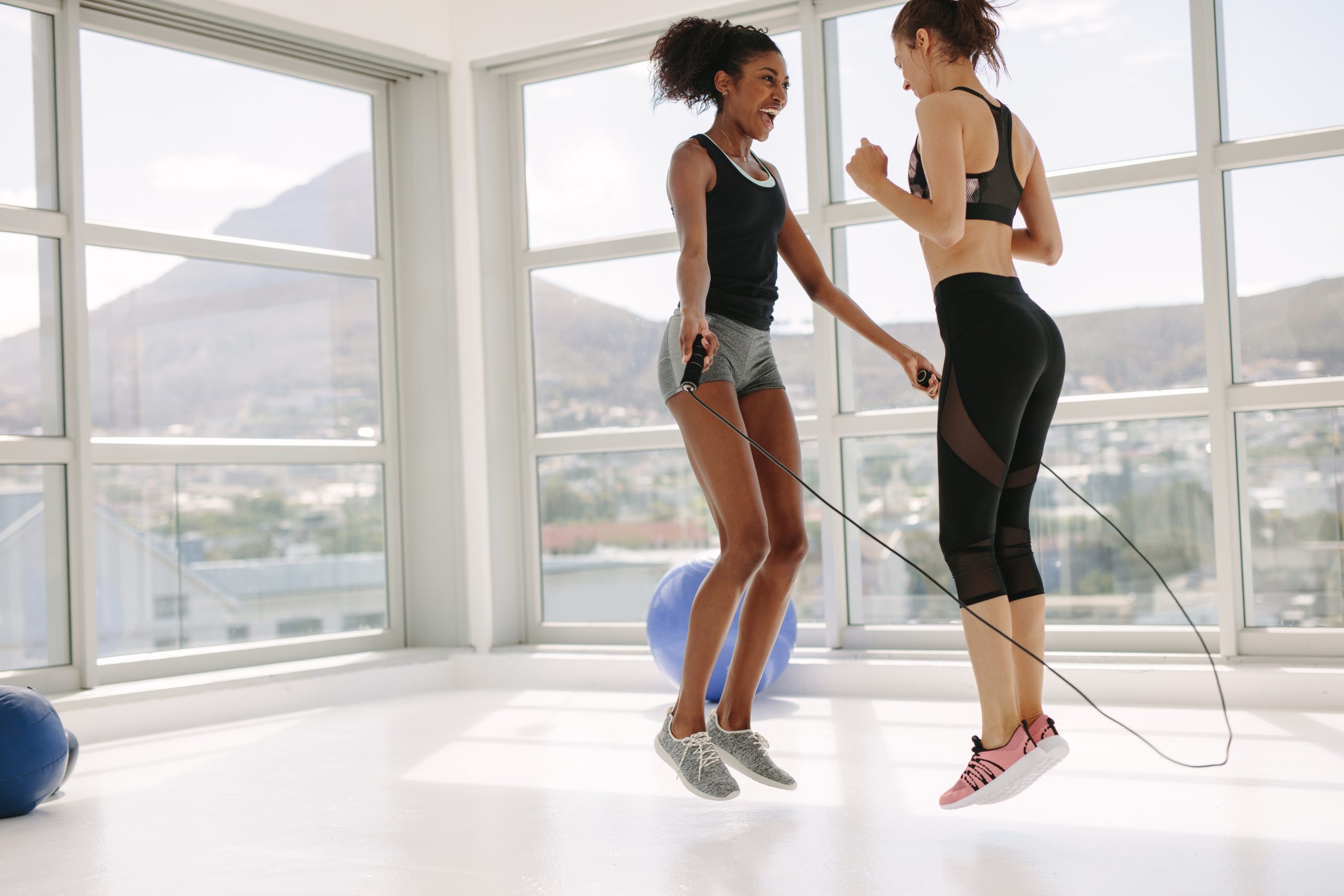Jump rope has to be one of the most nostalgia-inducing pieces of gym equipment. For many, it conjures up memories of grade school playgrounds and double-dutch tournaments. And while this exercise looks a lot less intimidating than a treadmill or other more advanced pieces of equipment, it can still give you an intense workout. But is jumping rope good cardio? The answer is a definite yes! It’s an excellent way to get your heart rate up, burn calories, and increase muscular strength and endurance. Read on to learn more about the benefits of this classic exercise, as well as tips for making the most out of each jump rope session.
Get your personalized
meal plan!
Is Jumping Rope Good Cardio?
What makes an exercise a cardiovascular activity?
Simply put, it’s an activity that uses large muscle groups repeatedly and rhythmically, which increases your heart rate. As for oxygen consumption, it’s an exercise that increases the need for oxygen. This is why running or biking are considered cardio exercises.
Jump rope definitely falls into this category. It’s a great cardiovascular exercise because it involves repeatedly and rhythmically using your arms, shoulders, core and legs. This increases your heart rate, and the longer you jump rope, the more calories you’ll burn.
Pros Of Jump Rope Workouts
Jumping rope can be an incredibly effective form of cardio for several reasons:
It Burns Calories
It’s estimated that only 15 minutes of jumping rope can burn approximately 200 to 300 calories (2). Most continuous cardio activities like walking burn fewer calories in the same amount of time.
The numbers are just an estimate; exactly how many calories you burn depends on your weight and the intensity at which you jump rope. But what’s guaranteed is that this thermogenic (calorie-burning) effect is cumulative, meaning the more you do it, the more calories you’ll burn.
Read More: Plyometric Jumping: Why And How It Works
It Improves Your Coordination
For you to balance on a day to day basis, you need to be able to coordinate your eyes and your limbs. This involves a system that allows you to integrate the different visuals, sensations and movements that your brain is receiving.
Jumping rope helps enhance this coordination as it requires you to focus on the rope and your body simultaneously. The longer you do it, the more coordinated you become. A study of autistic children found that jumping rope improved their coordination and balance significantly (3).
It Improves Your Heart Health
When you jump, the rope’s intensity has the potential to raise your heart rate up to 170 bpm (7).
This kind of intensified movement can be beneficial as it triggers a higher release of epinephrine (commonly known as adrenaline) and norepinephrine, which are hormones that can help improve blood flow and stimulate your heart.
Furthermore, jumping rope helps improve your capacity for aerobic exercise by increasing your ability to use oxygen efficiently.
It Strengthens Bone Density
Bone density refers to the amount of calcium and other minerals found inside your bones. The more dense your bones are, the stronger they become.
Weight-bearing exercises like jump rope have been found to help improve bone density, especially in postmenopausal women (5).
Offers Stress Relief
What we call stress is often a combination of physical and mental fatigue. In this sense, any activity that helps burn off excess energy can be therapeutic.
Jumping rope is a high-energy activity that releases endorphins, which are hormones associated with feelings of euphoria and positivity (4). It also helps you take your mind off of the day’s troubles, allowing you to focus on the task at hand while helping you blow off some steam.
Reduces Injury Risk
Improving your balance and coordination is a great way to reduce your risk of injury.
Studies have found that people who practice balance exercises such as jumping rope have an increased ability to react to unexpected situations, which can help you avoid falling or slipping (6).
Offers A Full Body Workout
When you jump rope, you not only get your heart rate up and burn calories; you also use several other muscles. The act of jumping itself activates your calves, quads and hamstrings.
To keep your balance, you’ll need to use core muscles to stay upright. You’ll also be using your upper body to rotate the rope. All in all, it’s an effective full-body workout that can be done in a short amount of time.
It’s Convenient
Jump rope requires minimal space and no special equipment, so it can be done almost anywhere. Plus, it doesn’t take long to get a good workout in, so it’s perfect for those with limited time.
It’s Incredibly Versatile
You can jump rope for as long or short of a period as you’d like, and mix up the intensity. You can also incorporate different types of jumps (like high knees) and intervals for a more challenging workout.
If you wish to free yourself from all the extra pounds that have been weighting you down for way too long, start using the BetterMe app and overhaul your entire life!
Cons Of Jumping Rope Workouts
Like any exercise, jumping rope has some potential drawbacks:
Stress On Joints
The repetitive motion of jumping can put stress on your joints, especially if you’re using the wrong technique. Make sure to land softly on the balls of your feet, and take breaks if you start to feel any pain or discomfort.
Setting aside adequate time for rest and recovery helps reduce the risk of injury and overuse (1).
Risk Of Injury
Compared to an activity like walking, the risk of tripping and falling while jumping rope is much higher. To reduce this risk, you want to jump on an even surface that’s free of obstacles, and ensure that your rope is properly sized for you.
It Requires Coordination
Since your success depends on coordinating the rope’s movement with your own, it takes some practice to get it right. It also helps to have good rhythm and timing, as this can make it easier to master the technique. If you don’t have these, it will take you a while to learn.
Can Be Boring
Jumping rope can be a great way to get in shape, but the monotony of the exercise can make it difficult to stick with in the long run. To combat this, mix up your routine by trying different types of jumps or adding intervals.
You can also try jumping with a partner or while you listen to music.
Not Suitable For Everyone
Jumping rope is not suitable for people with certain physical or medical conditions, such as injuries, joint pain, or weak bones. If in doubt, consult your doctor before attempting any kind of workout routine.
Making The Most Of Jumping Rope
Jumping rope is a great way to get in shape and stay healthy but like most workouts, you must approach it strategically to reap the best benefits.
Have A Workout Plan
You should have a plan when you go into your jump rope session. Choose the type of jumps, sets and repetitions that you want to do, and stick to that plan. This will help you stay focused and motivated.
As a beginner, you may want to start with a 5-10 minute session, 2-3 times a week. Increase the duration and frequency of your workout as you get more comfortable with jumping rope.
Warm Up
Always warm up before you start your session. This will ensure that your muscles are properly prepared for the workout, reducing the risk of injury.
An ideal warm up session should last for 5-10 minutes and include some light cardio, like jogging or jumping jacks. You can also do some dynamic stretching to get your body ready.
Read More: Benefits Of Jumping Rope For 5 Minutes
Cool Down And Stretch
Cooling down is just as important as warming up. This will help slow your heart rate and give your body the chance to recover from the workout.
Include some light stretching after your session, focusing on areas that were used during the workout. This will help reduce soreness and improve your flexibility.
Use Proper Technique
To get the most out of your jump rope routine, make sure you’re using the correct technique. Keep your elbows close to your body, jump on the balls of your feet, and land lightly, with minimal impact.
Avoid arching your back or swinging your arms too much, both of which can lead to injury. If you’re not sure about the technique, seek out a certified personal trainer to help you.
Stay Motivated
Staying motivated is key to sticking with any exercise program. Find ways to keep your jump rope routine interesting, such as varying the type of jumps or playing music while you jump. You can also use a jump rope tracker to keep track of your progress and stay motivated.
Nourish Your Body
Regular exercise should be complemented with proper nutrition. Make sure you’re eating enough to fuel your workouts and getting the right nutrients to promote muscle recovery and growth.
Aim for a balanced diet that includes plenty of fruits, vegetables, lean proteins, and complex carbohydrates. Stay hydrated and get enough sleep to ensure your body is in tip-top shape.
Don’t Forget Rest And Recovery
Rest and recovery is important for any kind of workout. Make sure you’re giving your body the time it needs to recover from your jump rope sessions. This includes taking at least one day off per week, and also allowing yourself periods of rest between sets.
Sleep is one of the most underrated recovery tools. Make sure you’re getting enough quality sleep each night to give your body the chance to fully recover from your workouts.
Yanking yourself back in shape has never been so easy with our game-changing fitness app! Start transforming your life with BetterMe!
The Bottom Line
Jumping rope is an effective and versatile exercise that can be done almost anywhere. It offers a wide range of potential benefits, from improved heart health to stronger bones.
However, it’s important to use proper form and technique, as well as the right size rope, to avoid injury or strain. Additionally, people with certain medical conditions may wish to consult their doctor before beginning any workout routine.
DISCLAIMER:
This article is intended for general informational purposes only and does not serve to address individual circumstances. It is not a substitute for professional advice or help and should not be relied on for making any kind of decision-making. Any action taken as a direct or indirect result of the information in this article is entirely at your own risk and is your sole responsibility.
BetterMe, its content staff, and its medical advisors accept no responsibility for inaccuracies, errors, misstatements, inconsistencies, or omissions and specifically disclaim any liability, loss or risk, personal, professional or otherwise, which may be incurred as a consequence, directly or indirectly, of the use and/or application of any content.
You should always seek the advice of your physician or other qualified health provider with any questions you may have regarding a medical condition or your specific situation. Never disregard professional medical advice or delay seeking it because of BetterMe content. If you suspect or think you may have a medical emergency, call your doctor.
SOURCES:
- 7 Guidelines for Injury Prevention (2018, health.uconn.edu)
- Calories burned in 30 minutes for people of three different weights (2021, harvard.edu)
- Effects of a 12-week structured circuit exercise program on physical fitness levels of children with autism spectrum condition and typically developing children (2020, nih.gov)
- Endorphins (n.d., clevelandclinic.org)
- Exercise for the prevention of osteoporosis in postmenopausal women: an evidence-based guide to the optimal prescription (2018, nih.gov)
- Jump Rope Training: Balance and Motor Coordination in Preadolescent Soccer Players (2015, nih.gov)
- The effects of rope training on heart rate, anaerobic power and reaction time of the basketball players (2013, researchgate.net)











